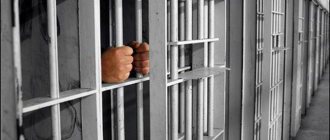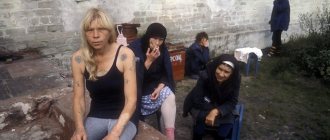This place has a long correctional history, dating back to 1775, with the construction of a straithouse for the “insolent” - petty thieves and swindlers. Then it was renamed the Moscow Correctional Prison and additional buildings were erected to house prisoners.
In 1918, a correctional facility for minors called the Reformatorium was created on the basis of the prison, and later they also began to hold tuberculosis patients there.
Matrosskaya Tishina began to fulfill its functions as a place of residence for adult criminals in 1946. At various times, the Soviet party elite, Russian oligarchs such as Mikhail Khodorkovsky and Sergei Polonsky, the nationally known swindler Sergei Mavrodi, and well-known personalities in the criminal world such as the killer Alexander Solonik and thief in law Yaponchik (Vyacheslav) visited here Ivankov).
Eletskaya "cover"
In the beginning, this prison, built in 1592, did not even have prison cells. Prisoners were placed in earthen pits covered with wooden planks. A wooden prison appeared in Yelets, presumably in 1763, and a stone one much later, in the 19th century.
See also: A resident of Tula returned the money for a low-quality product through the court
Many political exiles passed through the Yeletskaya “krytka”, including Druzhinin, Kamenitsky and Chigirinsky. Bunin mentioned this establishment in his books.
Prisoners in the Yeletsk prison were not treated on ceremony. For the slightest offense, prisoners were placed alone without food or water and were severely beaten.
Nowadays, of course, prisoners are not treated this way. However, conditions in Yeletskaya prison remain among the harshest, which is not surprising given the local population. About 80% of prisoners are imprisoned for murder, robbery and rape.
According to unofficial information, cases of beatings and other types of violence against prisoners are not uncommon in the Yelets “krytka”. And there were several suicide attempts by prisoners who could not stand the abuse.
Conditions of detention
In Yeletskaya prison there are both modern, more comfortable cells, and outdated, standard options. Comfortable cells have separate rather than bunk beds. There is all the furniture necessary for a normal existence, the flooring is linoleum. Some rooms have a radio or TV and a small refrigerator. Such chambers are designed for 3-5 people. More comfortable rooms are intended for prisoners serving time under general conditions.
Standard cameras are less conveniently equipped . They have “two-story” bunks and a completely open bathroom (sewerage and a place for washing), i.e. there is no possibility of privacy to relieve oneself. Such cells can accommodate up to 10 people.
The management is addressing the issue of improvement and plans to improve the living conditions of all prisoners, regardless of the regime.
There are also so-called “guest cells” where a prisoner can live for some time with his family. They have everything you need for a short stay - beds, bedside table, small refrigerator, radio. There is a small kitchen and a bathroom. “Guest cells” are provided only by agreement with the prison administration.
There is a laundry complex on the territory of the prison. Laundry is done there almost every day. Convicts receive a clean set of linen once a week. Prisoners' personal belongings are not required to be washed in this complex, but there is an opportunity to negotiate. In order for prisoners to wash themselves, they are provided with a bathhouse once a week. However, information has repeatedly appeared that in Yeletsk prison there is no opportunity to wash properly; convicts are not taken to the bathhouse for months (they wrote about this here - https://www.index.org.ru/turma/zh/pt/pon031103.htm).
Schedule
The daily routine of convicts serving sentences in correctional institutions for acts they have committed is established by Order of the Ministry of Justice of the Russian Federation dated November 3, 2005 No. 205. In accordance with this order, each correctional institution must be guided by a strictly regulated daily routine:
- The rise of convicts is carried out no later than 6 a.m. local time.
- Physical training (exercise) lasts for 15 minutes.
- It takes up to 10 minutes to make the beds and use the toilet.
- The morning inspection of prisoners for any types of damage, as well as their beds, including morning and evening checks, is carried out for 40 minutes.
- First meal (tomorrow) – up to 30 minutes a day.
- Distribution to workplaces takes up to 40 minutes.
- Working hours for prisoners are established directly by the legislation of the Russian Federation, namely Ch. 14 Penal Code of the Russian Federation, art. 104, art. 91-92 of the Labor Code of the Russian Federation, art. 212 Labor Code of the Russian Federation.
- The second meal (lunch) is also 30 minutes long.
- Retirement from work, as well as evening dressing - 25 minutes.
- The third meal (dinner) is given up to 30 minutes.
- Prisoners' personal time varies from half an hour to 60 minutes.
- Educational work with prisoners – 1 hour.
- Cultural work, educational events, training - are established separately depending on the type of work.
- 10 minutes are allotted for getting ready for bed.
- Sleep – 8 hours.
Meals in Yelets prison
In accordance with the daily routine, prisoners serving their sentences are given 3 meals a day, including bread, porridge or stew, main courses, tea or compote.
Sometimes they give fish, meat, sometimes vegetables. A serving of the first course is approximately 300 g, a side dish is 200 g, and porridge is 250 g. A serving of meat or fish dish is about 80 grams, a drink is 200 ml.
In addition to this, prisoners can go to the kiosk, however, the permissible monthly expenses for it depend on the regime of detention:
- the general regime provides for up to 1 minimum wage per month in addition to earnings;
- strict - a maximum of 60% at the minimum wage per stall in addition to earnings.
Job
For the work of prisoners there is a poultry house, a bakery and workshops - woodworking, metalworking, and a sewing workshop. The prison has also established the production of laundry soap, which is in demand from Murmansk to Astrakhan. The product is produced strictly in accordance with GOST and from natural raw materials.
Work is determined depending on the professional skills acquired in the wild, abilities or on the initiative. The work helps to avoid the monotony of imprisonment and obtain additional financial resources.
Studies
In accordance with No. 273-FZ “On Education in the Russian Federation”, as well as Art. 108 of the Penal Code of the Russian Federation, those sentenced to imprisonment have the right to receive vocational education and undergo appropriate training. In the MLS, convicts can receive secondary vocational education under a program for training skilled workers (if they do not have a specific profession at the time of serving their sentence).
It is important to take into account that the attitude of a convicted person to obtaining secondary or secondary vocational education is directly taken into account when determining his degree of correction in order to obtain the possibility of parole.
Many “krytka” prisoners read a lot and engage in self-education, but they are not interested in receiving a full-fledged education.
Religious issues
Considering that a different contingent is sent to places of deprivation of liberty - believers, atheists, agnostics and others, with regard to religious issues everything is purely individual (regulated by No. 125-FZ “On freedom of conscience and religious associations”).
Since the vast majority of those arriving here are Orthodox , a bishop or priest is sometimes invited to the prison grounds so that prisoners can confess and receive communion. Clergymen also give lectures and engage in religious education of prisoners and prison workers, calling for the preservation of humanity and philanthropy. And for representatives of other faiths there is a special prayer room.
Entertainment and relaxation
In accordance with the Order of the Ministry of Justice of the Russian Federation dated November 3, 2005 No. 205, convicts are allocated from 30 to 60 minutes for entertainment and recreation. It is in their personal time that those serving their sentences have the right to deal with their personal issues - read, discuss something with other prisoners, etc. In “Krytka” there is a library, a games room, a TV, and a gym.
Most prisoners prefer to read or play board games - checkers, backgammon, dominoes.
Dates and visits
In Yeletsk prison, meetings with convicts and visits to relatives are allowed . There is a strictly designated time period for this, and a prisoner can be visited literally any day from 8 a.m. to 5 p.m. However, it is important to remember that you cannot have sharp piercing or other objects prohibited on the territory of a correctional institution with you or in transit.
The only day when the visiting room may be closed is the last Sunday of each month. This is a sanitary day.
The number of dates directly varies depending on the type of content:
- General regime prisoners are entitled to only 2 long visits and the same number of short visits per year;
- the strict regime of detention provides for only 2 short-term visits per year.
Transfer of products and things
The transfer of products, as well as things for convicts, is carried out strictly within established time intervals and includes a preliminary check for the presence/absence of things prohibited on the territory of the correctional institution.
Reception of food and things for convicts is carried out strictly from 8-15 hours, daily. The delivery of received parcels is carried out from 15 to 17 hours . Just like visits, transmissions are not allowed to be received every day and depend on the type of regime:
- the general one provides for the annual receipt of up to 2 parcels and parcels;
- strict – 1 parcel and 1 parcel per year.
Punishment cell
The punishment cell (punishment cell) of the Yeletskaya “krytka” is known to many violent prisoners . This is the place no convict wants to end up in. A punishment cell is assigned to persons who not only have an extremely negative attitude towards the administration of the place of deprivation of liberty, but also manifest themselves in an aggressive manner while in the cell.
As a result, the guilty prisoner is placed in a small cell, with a small window and bars, a bed on which you cannot even sit, with empty bare walls. The prisoner spends the additional sentence assigned to him, without communication, walks, etc. And the guards constantly “remind themselves” so that the prisoner does not relax.
Butyrka prison
Butyrka is the largest prison in Moscow and one of the oldest prisons in Russia. It was founded during the reign of Catherine II, as, by the way, was the Vladimir Central. Once upon a time, Butyrka Prison was the central transit point for those traveling to Siberia.
And in the period from 1937 to 1938, up to 20 thousand people were kept in Butyrka, many of whom were shot.
But the fame of the Butyrka prison is connected not so much with the date of construction and the number of prisoners, but with the personalities of those who happened to be in it (and these are Emelyan Pugachev, Osip Mandelstam, Nestor Makhno, Sergei Korolev, Alexander Solzhenitsyn, etc.) and frequent mention in the literature, cinema and music.
Even nowadays, prisoners are kept in poorly ventilated, stuffy and small rooms, and prisoners have to sleep in 2 or even 3-4 shifts, depending on the number of prisoners in the cells.
Vologda nickel
The institution, once known as the Kirillo-Novoezersky Monastery for men, and then as a prison for “enemies of the revolution,” is now one of the few Russian special regime colonies for life prisoners - pedophiles, murderers, etc.
Their cells are searched daily, and after being woken up and their beds are made, prisoners are not allowed to sit or lie down during the day.
Considering the specifics of the place, many prisoners talk about mystical events occurring within the walls of the Vologda Pyatak. For example, that angels, saints, the souls of murdered people, and even the spirit of Vasily Shukshin, who once visited the prison to film the film “Kalina Krasnaya,” appeared to them.
Features of the prison regime of this MLS
In FKU T-2 there are both those under investigation and those convicted. On the territory of the Yeletskaya Krytka there is not only a prison, but also a pre-trial detention center.
The only difference is that the former are isolated from society during the investigation, while the latter have already received their sentence and are serving it. It is noteworthy that it is the untried prisoners in prison who make up the majority of them. In general, they all have to “cohabit” together in one way or another until the end of their term.
Lefortovo prison
The most closed of Russian prisons was originally a military prison, which housed people convicted of minor crimes.
During the Great Terror, the NKVD used the prison as an interrogation and torture facility. And from 1954 to 1991, it served as a pre-trial detention center for the KGB of the USSR, where many dissidents visited, for example Alexander Solzhenitsyn.
Now Lefortovo prison has turned into a pre-trial detention center, where journalists are not allowed, where there are no excursions and no museum, unlike most other prisons on this list. Here the defendants are awaiting trial. The Lefortovo prison housed the “ex-hope of Ukraine” Nadezhda Savchenko and Svetlana Davydova, suspected of high treason in favor of Ukraine.
Expert opinion
Roshchina Christina
A unique feature of Lefortovo prison is the absence of an internal hierarchy and problems with the supply of alcohol and drugs. This was achieved due to the fact that those arrested from different cells do not contact each other.
White Swan
This name was given to the prison unofficially. The most popular version of its origin is associated with the posture of prisoners who move along the corridors of a correctional facility leaning forward at an angle of 90 degrees and with their arms behind them.
There are people sentenced to life imprisonment in the White Swan. They are allowed to receive letters from loved ones after ten years in prison.
Black golden eagle
In the Ural wilderness there is another colony with a bird's name, in which, until recently, either long-term or life-sentenced persons - maniacs, murderers and rapists - served their sentences.
Due to the harsh conditions of detention, many Black Golden Eagle prisoners went crazy after 10 years in prison.
The prison was closed in 2021 due to persistent complaints about terrible sanitary conditions and unprofitability, but its future remains uncertain. Perhaps the frightening “Black Golden Eagle” will be turned into a tourist attraction for those who want to tickle their nerves. This is, perhaps, the best solution for residents of nearby villages, because there is simply no other work there.
See also: Marriage annulment in 2021. Arbitrage practice
The most famous prisoners and escapes
For example, in 2021, Tengo Potisky, who arrived here in 2017, was located in the Yelets “krytka” . At that time, Borisov K.G., better known as Kostyl, was kept here, as well as Kotua M.G. or Maho Ochamchira.
Other equally well-known personalities in the criminal environment also left their mark on the history of this correctional institution:
- Kalashyan G.K. (Georgy Tbilissky) - criminal figure and thief in law;
- Oniani T. G. (Taro) - one of the leaders of the “Kutaisi criminal group”;
- Novikov I.I. (Novik) is another thief in law who spent most of his life behind bars;
- Nekrasov V. A. (Spider Lipetsky), etc.
Even the worst lawbreakers within these walls refused the idea of escaping . The last successful escape from here was made in the first years of Soviet power. Today, the security system has been modernized (video surveillance, fingerprint equipment), and more than 1,500 employees are always on alert. It is also worth mentioning the four-legged helpers - huge, fast Caucasian and German shepherds. The dogs are well trained and are ready to overtake the intruder at any moment.
Vladimir Central
The prison for especially dangerous criminals, sung in the songs of Mikhail Krug, has long been characterized by harsh conditions of detention. It is alleged that there was not a single successful escape from it.
In the 20th and 21st centuries, such famous prisoners as German field marshal Friedrich Paulus, singer Lidia Ruslanova, Berlin commandant Helmut Weidling and the famous Stalinist “wolfhound” Pavel Sudoplatov visited the Vladimir Central.
The most dangerous prisoners, who have nothing to lose, are kept in a special unit under the tightest possible control. Such prisoners walk along the corridors under heavy escort, and their cells are opened in the presence of a dog handler with a dog and the assistant warden on duty. However, such conditions are considered hothouse compared to the most terrible prison in the world.
polar owl
This colony for life prisoners, located in the Yamal-Nenets Autonomous Okrug, opened back in 1961. Its first “guests” laid the Trans-Siberian Railway for the country.
In 2004, Polar Owl received the status of a place where especially dangerous criminals will serve life sentences. Little is known about what is happening behind the walls of this prison, but from time to time loud scandals associated with it arise.
Thus, in 2014, FSIN officer Yuri Sandrykin was convicted, who in 2010 was involved in extorting confessions from prisoners, having managed to obtain 190 confessions. Moreover, the cases were high-profile, such as the murder of journalist Anna Politkovskaya, the first president of Chechnya Akhmat Kadyrov and Magadan governor Valentin Tsvetkov.
Those who refused to take the blame were subjected to mental, physical and even sexual violence.
Black Dolphin
The video of Russia's worst prison may not convey the fear and despair of those who find themselves there forever. People do not go free from the Black Dolphin; this place is intended for the real “dregs of society” - cannibals, terrorists, serial killers, etc.
Prisoners are monitored around the clock, and they move along the corridors in handcuffs and under escort. When moving from building to building, the prisoner is blindfolded so that he cannot remember the layout of the prison.
Given such strict security measures, it is not surprising that no one ever escaped from the Black Dolphin.
The following are serving their sentences in this prison: the maniac Vladimir Mukhankin, who killed 8 people, the rapist and murderer Vadim Ershov, whose victims were 19 people, the terrorist Tamarlan Aliyev, who blew up a house in Makhachkala, and many other dangerous criminals.
Do prisoners have the right to parole?
The possibilities and requirements for prisoners to receive parole are regulated by Art. 79 of the Criminal Code of the Russian Federation. Accordingly, this is only possible if it is proven that the person has “embarked on the path of correction” and does not need to fully serve the previously assigned sentence. Parole may be assigned if :
- when committing a serious crime - at least half of the appointed term;
- at least two thirds when committing a particularly serious crime;
- three quarters when committing a crime against the sexual integrity of minors or drug trafficking;
- 4/5 of the term - in case of rape of a minor under 14 years of age.
It is important to take into account that the receipt of parole is influenced by the recommendation of the administration of the place of deprivation of liberty, as well as the behavior of the prisoner himself while serving his sentence.
What is a “covered” colony or “lid”
. There is no need to explain to the people sitting what a “krytka” is according to the criminal. This is the slang term for prison-type correctional facilities and prisons that house only those convicted of particularly serious criminal charges. The special regime of their detention is similar to the conditions of a pre-trial detention center, where all prisoners are kept in cells, and not in barracks, as is the case in the zones
Expert opinion
Roshchina Christina
The word “cover” got into the jargon from the concept of “covered”. Externally, the buildings of such institutions are no different from pre-trial detention centers. According to the Federal Penitentiary Service, there are currently only 8 high-security prisons operating in Russia.
Each of them has its own history and characteristics. Currently, they house just over 1,100 prisoners. Half of these closed institutions are located in Siberia.
Brief description of the Yeletsk maximum security colony
Official name : Federal State Institution Prison-2 is located at the address: Yelets city, Proletarskaya street, 1B.
Postal code
Special unit telephone numbers : +7 (47467) 4-15-51, +7 (47467) 2-20-06. Secretariat phone number : +7 (47467) 7-18-47. You can contact them for detailed information about the meeting, delivery of parcels, as well as making an appointment for personal matters.
Schedule for receiving appeals from convicts, suspects, accused and citizens:
| Position, full name reception person | Days of the week |
| Monday. Prevention Council office:
|
| Tuesday. Prevention Council office:
|
| Beginning labor adaptation center major ext. sl. Demkin V.V. | Wednesday. Prevention Council office:
|
| Thursday. Prevention Council office:
|
| Friday. Prevention Council office:
|
Page on the website of the Federal Penitentiary Service of the Russian Federation - https://www.48.fsin.su/structure/tyurma-2.php . Here are the details:
- bank details of the organization;
- location of FKU T-2;
- full legal name;
- information about superiors.
An email address is also provided to which you can send any questions you have and receive an answer.
Map - how to get there
Visiting room opening hours
The meeting room is open daily from 8:00 to 17:00 . The lunch break is 1 hour and lasts from 12:00 to 13:00. When visiting prisoners, it is important to remember that the last Sunday of each month is a sanitary day and visits are prohibited at this time. Reception of transfers from loved ones is carried out every day from 8:00 to 15:00. Delivery takes place from 15:00 to 17:00.
Infrastructure
On the territory of the penitentiary institution PKU T-2 Yeletskaya prison, there is a famous museum called the “Eletsk prison”. It was opened quite recently - in 2011 on the territory of the oldest building of the institution (1860). It is this museum that is the main asset of the Yeletskaya “krytka”. In total, the museum consists of 8 rooms that display four eras - 1864-1900, 1900-1917, 1917-1940, 1940-1990.
The first four cells recreate prison life from the mid-19th century. until the end of the 20th century. Opposite them there are 3 information chambers in which archival documents, models and other exhibits are displayed. The last room is a stylized office of the warden of the late 19th century. Near each cell there is a “warden” in uniform of the appropriate period. The guide will tell you how the prison was built, what the conditions of convicts were and how the penal system itself changed over time.
It is also important to note the fact that you will not be able to gain access to the museum or enter it simply by purchasing a ticket. To do this, you need to agree in advance with the administration, discuss all the conditions, and only after that, you can see the whole history of this institution with your own eyes.
Previously, there was a small church named after Tikhon of Zadonsk on the territory, where prisoners could atone for their sins. It was located on the top floor of the prison castle and initially did not have a church ending on the roof of the building. Only almost half a century later, in 1902, under Bishop Irenaeus, the interior of the temple was renovated and a dome with a cross was built over it. The church was wooden, lavishly decorated with carved towels, flies and belts. Instead of windows, threads with images of saints were placed at the cardinal points. The central place was occupied by the icon of St. Tikhon of Zadonsk. Inside, the small prison church was decorated with other picturesque icons, expensive vestments and rich vestments.
For training and guidance on the true path, there was a school at the church and readings were established . There were also two libraries: an educational one for the school and a general one with religious, moral and popular scientific books.
But after the revolution it was destroyed. Not a trace remains of the prison church: the temple top was dismantled along with the roof and in place of the third floor in the 1970s. An open, roofless exercise yard for prisoners was built.
Currently, one of the prison premises is temporarily used for church services, and restoration work is being carried out by the prison management.
How does a “lid” differ from a regular colony?
Existing closed institutions designed to hold convicts differ in the regimes and conditions of their detention. An ordinary colony resembles a settlement behind barbed wire, in which prisoners live in dormitory-style barracks. They are not allowed to leave the colony, but they can move freely within its territory.
Labor plays an important role in the correctional and educational process. Prisoners serving their sentences in a colony can work, receive wages for their work and spend it in trading stores opened on the territory of the colony. In prisons, prisoners are kept in cells, are not required to work and are taken for walks under escort.
This is how “covers” differ from zones. It is customary for prisoners sent to serve time in prison to say “go to hell.”
Story
The history of the Yeletsk prison begins back in 1592, when the archer Deacon was imprisoned in it , however, at that time these were only earthen ditches, covered with boards and fenced with tyne. Subsequently, a wooden building was built where various criminals were kept, but due to the fire it was significantly damaged.
The stone building was approximately erected in 1830. Confinement in this place of deprivation of liberty has long been considered one of the most cruel, when even for a minor offense prisoners were chained to a cell, could not move freely or sleep in it, and in exceptional cases were placed in solitary confinement, where were kept for many days without food, in complete darkness.
Yelets prison or “krytka” got its name directly because of its location. It is located in the city of Yelets. However, another name - “Red Stripe”, which was given to this place, was adopted for a completely different reason. In the prison world, the color red mainly means “cop lawlessness.” This is how the name Yeletsk prison came into use in the criminal world, as “Red Stripe”.
There are a large number of colonies in Russia, known even abroad for their cruel conditions of detention. Read about the most terrible prisons such as the White Swan, Black Golden Eagle, Black Dolphin, Snowflake, New Crosses, Polar Owl, Vologda Pyatak, Matrosskaya Tishina and Vladimir Central on our website.







